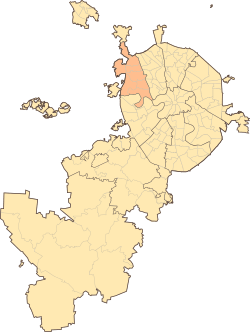North-Western Administrative Okrug
| North-Western Administrative Okrug Северо-Западный административный округ | |||
|---|---|---|---|
| Administrative okrug | |||
| |||
 North-Western Administrative Okrug in Moscow | |||
| Coordinates: 55°49′N 37°26′E / 55.817°N 37.433°ECoordinates: 55°49′N 37°26′E / 55.817°N 37.433°E | |||
| Country | Russia | ||
| Federal city | Moscow | ||
| Districts[1] | 8[2] | ||
| Government | |||
| • Prefect | Alexey Pashkov | ||
| Area | |||
| • Total | 93.281 km2 (36.016 sq mi) | ||
| Population (2010 Census)[3] | |||
| • Total | 942,223 | ||
| Website | http://szao.mos.ru | ||
North-Western Administrative Okrug (Russian: Се́веро-За́падный администрати́вный о́круг, Severo-Zapadny administrativny okrug), or Severo-Zapadny Administrative Okrug, is one of the twelve high-level territorial divisions (administrative okrugs) of the federal city of Moscow, Russia.[1] As of the 2010 Census, its population was 942,223,[3] up from 779,965 recorded during the 2002 Census.[2]
Geography
Its borders with Northern and Central Administrative Okrugs in the east and passes by the Khimki Reservoir and the Moscow District Railway. In the south, it borders with Western Administrative Okrug and the bed of the Moskva River.
History
The North-Western Administrative Okrug was formed in 1991 from Tushinsky and Khoroshevsky Districts of Moscow. The administrative okrug is sometimes referred to as "the lungs of the capital", as it is surrounded by the Khimki Reservoir, the Moskva River, and the Moscow Canal, with about 46% of its territory covered by natural features.
Until the beginning of the 20th century, what is now the administrative okrug's territory was home to peasant settlements in the Moscow suburbs: Spas, Tushino, Strogino, Streshnevo, Khoroshevo, Shchukino, and others, which were incorporated into the boundaries of the city over the last fifty years. Many historical and cultural monuments reside within the okrug, such as the Trinity Church (in Khoroshyovo), as well as the stone church of the Vladimir Icon of the Mother of God, which was built in 1672 and has been preserved to this day.[4]
Territorial divisions
The administrative okrug comprises the following eight districts:[2]
- Kurkino
- Mitino
- Pokrovskoye-Streshnevo
- Severnoye Tushino
- Strogino
- Shchukino
- Khoroshevo-Mnevniki
- Yuzhnoye Tushino
References
Notes
- 1 2 Law #13-47
- 1 2 3 Russian Federal State Statistics Service (May 21, 2004). "Численность населения России, субъектов Российской Федерации в составе федеральных округов, районов, городских поселений, сельских населённых пунктов – районных центров и сельских населённых пунктов с населением 3 тысячи и более человек" [Population of Russia, Its Federal Districts, Federal Subjects, Districts, Urban Localities, Rural Localities—Administrative Centers, and Rural Localities with Population of Over 3,000] (XLS). Всероссийская перепись населения 2002 года [All-Russia Population Census of 2002] (in Russian). Retrieved August 9, 2014.
- 1 2 Russian Federal State Statistics Service (2011). "Всероссийская перепись населения 2010 года. Том 1" [2010 All-Russian Population Census, vol. 1]. Всероссийская перепись населения 2010 года (2010 All-Russia Population Census) (in Russian). Federal State Statistics Service. Retrieved June 29, 2012.
- ↑ (in Russian)History of the North-Western Administrative Okrug Retrieved on October 30, 2009
Sources
- Московская городская Дума. Закон №13-47 от 5 июля 1995 г. «О территориальном делении города Москвы», в ред. Закона №38 от 26 июня 2013 г. «О внесении изменений в статью 4 Закона города Москвы от 5 июля 1995 г. №13-47 "О территориальном делении города Москвы" и Закон города Москвы от 15 октября 2003 года №59 "О наименованиях и границах внутригородских муниципальных образований в городе Москве"». Вступил в силу с момента опубликования. Опубликован: "Вестник Мэрии Москвы", №14, июль 1995. (Moscow City Duma. Law #13-47 of July 5, 1995 On the Territorial Division of the City of Moscow, as amended by the Law #38 of June 26, 2013 On Amending Article 4 of the Law of the City of Moscow of July 5, 1995 #13-47 "On the Territorial Division of the City of Moscow" and the Law of the City of Moscow of October 15, 2003 #59 "On the Names and Borders of the Internal Municipal Formations in the City of Moscow". Effective as of the moment of publication.).


